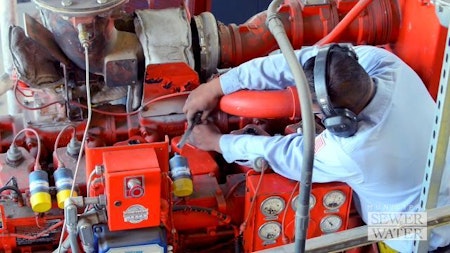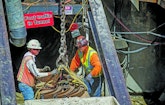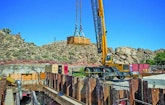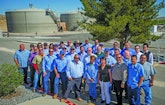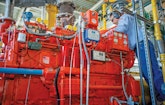
Interested in Infrastructure?
Get Infrastructure articles, news and videos right in your inbox! Sign up now.
Infrastructure + Get AlertsIf California’s Victor Valley Wastewater Reclamation Authority (VVWRA) could wrap up its mission in a single sentence, it might be “to take the waste out of wastewater.” In recent years, the authority has increased efficiency at the plant, reduced power consumption and inaugurated the Anaergia’s Omnivore Biogas Renewable Energy Project, a unique wastewater-to-energy program.
The VVWRA is located at the southwestern edge of the Mojave Desert, about 80 miles northeast of Los Angeles. It was formed in 1976 and serves the wastewater needs of 250,000 residents in Victorville, Apple Valley, Hesperia and small parts of San Bernardino County, including Oro Grande and Spring Valley Lake. The authority treats between 12 and 13 million gallons of wastewater per day at its Victorville wastewater treatment facility.
The authority manages 41 miles of trunk sewer while member communities manage their own sewage collections systems.
Pipe capacity biggest issue
“The oldest parts of the trunk line date back to 1982, so it’s a fairly young system,” says Logan Olds, general manager of the VVWRA. “The smallest lines are 8 inches in diameter and the largest are the 42-inch force mains. However, the region is experiencing enormous growth. Housing prices are more affordable here, and the biggest issue we’re facing is the capacity of the pipe to serve the growing population.”
Driven by the twin engines of drought and operational efficiency, member communities are investing in recycled water. The City of Victorville produces 2 million gallons of recycled water per day at its main plant, and two new water-scalping plants have recently broken ground in Apple Valley and Hesperia. On completion, they’ll each provide up to 1 million gallons of recycled water per day to local parks and golf courses.
Watch: "Virtual Tour of Victorville"
“However, between population growth and having to convey the remaining highly viscous wastewater after recycled water is removed, capacity is still an issue,” Olds says.
The trunk line pipes are made of a variety of material from fused HDPE to fused PVC and vitrified clay. Force mains are made of steel.
“The overall condition of the pipes is quite good,” says Olds. “In some areas where the pipe runs really flat we have a problem with hydrogen sulfide, so that might lead to the premature replacement of some manhole frames and covers.”
The system is completely inspected every five years by third-party contractors, employing CCTV inspection, sonar scanning for pipe defects and bucket cleaning.
A drive for efficiency
Operational efficiencies continue to drive decisions made by the authority. Southern California Edison recently presented the VVWRA Board with an incentive refund check for almost $50,000 for an energy efficiency program developed by VVWRA Director of Operations Gilbert Perez and his staff. Under the program, the authority established a new protocol for operating the wastewater treatment plant’s UV disinfection lights, resulting in significant energy savings.
The authority’s signature energy efficiency achievement has been the development of the Omnivore Biogas Renewable Energy Project, a partnership between VVWRA and Anaergia, a global resource recovery and renewable energy company. The first program of its kind in North America, it uses Anaergia’s Omnivore technology, a process that thickens sludge and increases the capacity of co-digestion inside a retrofitted anaerobic digester. The result is a dramatic increase in the production of biogas, which is used to generate electricity for wastewater plant operations.
“Gilbert and I are believers in operational efficiency,” says Olds. “In the summer of 2008, we had built two new digesters and were planning to decommission three smaller digesters. We reasoned that when you buy a new car, you don’t just drive the old one off a cliff. Based on our anaerobic digestion capacity using conventional active sludge, if we planned carefully, we could retrofit those digesters to generate enough power to become energy neutral.”
The authority already used a portion of the gas generated through anaerobic digestion to power some of the blowers used at the plant. However, much of the gas was being flared off while the wastewater plant consumed about $40,000 in natural gas each month. VVWRA’s electricity bill approached $1 million annually.
Leveraging partnerships
Anaergia had been looking for a place to demonstrate its Omnivore technology and had already secured a $2 million grant from the California Energy Commission. As part of a public-private partnership, Anaergia would contribute $600,000 in funding and equipment, while entering into a 20-year power purchase agreement with the authority. The VVWRA would use as much electricity as required to achieve energy independence, and excess electricity would be sold to the grid.
Using proprietary thickening and mixing solutions, Omnivore can increase the total solids content in a typical digester from 2 percent to 6 percent while significantly increasing biogas production.
Creating a successful value proposition was key to gaining support for the project.
“We went straight to our customers to harness their interest and guessed correctly that their enthusiasm for the project would convince elected officials and the chamber of commerce that they should also support the project,” Olds says.
Once the project was approved, the Environmental Protection Agency provided technical assistance and helped conduct a plant energy audit with the cooperation of the U.S. Department of Energy.
“A fraction of a penny in the price of electricity can make or break a project, so we had to calculate this correctly,” says Olds. “We calculated that over 20 years we could save the authority about $9 million in energy costs. We retrofitted the three smaller digesters to operate with Omnivore. By decoupling the hydraulic retention time from the solids retention time, we’re also moving water from the system more quickly, increasing our plant capacity.”
An added potential bonus — Omnivore can consume fats, oils, greases and food processing waste that can be added to the digester to produce more biogas.
Easy to adapt
Little work was required on the wastewater treatment plant side to accommodate the project.
“We had to add a gas conditioning system, using ferric to reduce hydrogen sulfide content,” says Perez. “Anaergia has a person who comes on site, but it hasn’t required us to devote any significant time to the project. We already have a solids team and they’re able to handle it in the course of their regular duties.”
VVWRA purchased two 800 kW co-generators from 2G – CENERGY Power Systems Technologies to convert the biogas to electricity.
A double membrane gas holder with a capacity of about 500 cubic feet of gas collects biogas from all the digesters, including the Omnivore-enabled units. The membrane ensures that gas pressure from the digesters is equalized to provide a steady flow of fuel to the co-generators.
The project was commissioned in spring 2014 for a 13-month demonstration period to ensure that all the metrics for the project could be realized.
“So far, we’re exceeding my expectations,” Olds says. “We are meeting 100 percent of our energy demand, and including the energy used at our two water reclamation plants, our entire system is 90 percent energy independent. We still have part of our footprint set aside for a third generator that may allow us to go completely off grid.”
